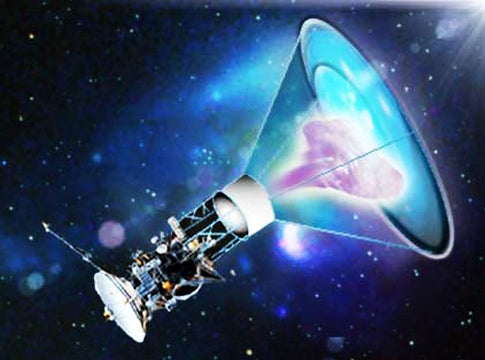Antimatter holds an obvious appeal for rocket scientists. The mutual annihilation of matter with the same mass of antimatter offers the highest energy density known. Just 100 milligrams of antimatter contains the energy expended in a single space-shuttle launch.
Imagining space uses for antimatter isn’t new. In 1935, just 3 years after scientists discovered the positron — the electron’s antimatter equivalent — Eugen Sänger, a German rocket designer, dreamt up a positron-powered vehicle. Sänger’s ship allowed electrons and positrons to combine, and the particles vanished in a flash of 511,000-electron-volt gamma rays. The rocket’s thrust came from bouncing these energetic gamma rays off a reflector. The trouble is, there’s no known way to reflect gamma rays in the way Sänger envisioned.
But Gerald Smith and his team at Positronics Research, LLC in Sante Fe, New Mexico, are taking another look at positron propulsion. The NASA Institute for Advanced Concepts (NIAC) is funding Smith and others to research possible designs for antimatter-powered spaceships. At a March NIAC meeting in Atlanta, Smith summarized various ideas. One relatively low-tech approach, called the positron solid-core design, could be a reality in just a few decades.
Stored positrons fired into a dense target material — called an attenuator -would annihilate and produce gamma rays. This energy would heat the attenuator and, in turn, heat liquid-hydrogen propellant streaming through it. Hot gas would shoot through a nozzle, pushing the spacecraft forward.
The system offers a specific impulse (rocketry’s equivalent to cars’ miles-per-gallon) about twice that of the space shuttle. Unlike a nuclear rocket, which would use a reactor to heat propellant, the positron engine requires no special shielding, no need for cooling when it’s shut down, and no complex control mechanisms. To turn it on, just start hydrogen and positrons flowing.
While this method requires the system to carry hydrogen fuel, it doesn’t need oxidizer to burn that fuel, which means it takes about half the mass of a traditional chemical engine. Smith estimates about 0.00014 ounce (4 milligrams) of positrons could drive a 220,000-pound (100,000 kilograms) piloted spaceship from Earth orbit to Mars in 6 months. The vessel would need the same quantity for the return trip, plus additional positrons if antimatter will be used to generate the ship’s electrical power — another facet Smith’s team is exploring.
Making the positrons — well, there’s the rub. Smith says it may cost $250 million to produce the number of particles needed for a Mars trip, and the technology to do so is still maturing. Costs may go down as new technologies bring more efficiency to the process, but, in any case, Smith says, the cost is competitive when compared to the much-larger Mars ship needed if chemical rockets are used.
Storing positrons presents problems, too. The particles must be kept from contact with matter using a combination of electric and magnetic fields. “We feel confident that with a dedicated research and development program, these challenges can be overcome,” Smith says.
Antimatter may extend the reach of robotic missions — perhaps even to the nearest stars. NIAC-funded studies by Chicago-based Hbar Technologies, LLC envision creating and storing anti-protons to power spacecraft deep into the Kuiper Belt. Hbar’s Steven Howe pictures a spacecraft attached to a 16-foot-wide (5 meters), curved, carbon-fiber sail. The sail’s inside surface has a coating of uranium.
Anti-protons released from the spacecraft strike this surface, annihilating a proton in a uranium nucleus. This makes the nucleus unstable and it flies apart. The fast-moving protons and neutrons released by such “microfission” reactions push the craft forward. Howe thinks a design like this might be able to deliver a small instrument package as far as 4.3 light-years to Alpha Centauri, the nearest star, but acknowledges it’s beyond the scope of any current technology.
This hasn’t stopped Howe and Hbar’s Gerald Jackson from exploring ways to acquire those antiprotons, though. In another NIAC-funded study, they’re investigating how to harvest antimatter from cosmic rays and the solar wind. Nested electrically charged wire spheres would first repel unwanted matter particles and capture the antiparticle prize. Developing the ability to capture and store natural antimatter would greatly reduce the costs associated with any propulsion technology based on it.
Antimatter-powered spaceships may be decades — but perhaps not centuries — in our future.










